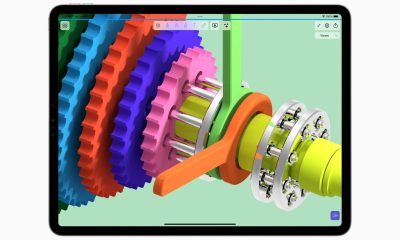Science
Boeing's Starliner Has Touched Down Safely in Desert After Failure to Dock With ISS – ScienceAlert

Boeing’s new Starliner unmanned spacecraft returned to Earth on Sunday, landing in the New Mexico desert in the United States six days early after a clock problem scuppered a rendezvous with the International Space Station.
NASA hailed the aborted flight as a success, despite its failure to reach the ISS on what was meant to be a final dress rehearsal before a crewed mission.
Images broadcast by NASA showed the spacecraft touching down, cushioned by airbags, after a pre-dawn descent slowed by three large parachutes.
“We had some challenges, but a lot of things did in fact go right,” NASA Administrator Jim Bridenstine told reporters, describing the landing as an “absolute bull’s-eye”.
“We did not make it to the International Space Station. We did not dock, but the spacecraft flew exceptionally well. We’ve got a lot of data to review.”
The Starliner capsule was launched Friday from Cape Canaveral in Florida, but shortly after separating from its Atlas V launch rocket, its thrusters failed to activate as planned, preventing it from reaching a high enough orbit.
The space station orbits at an altitude of about 400 kilometers (250 miles) above sea level.
As the craft had burned too much propellant, Boeing and NASA were forced to guide the Starliner back to Earth.
“Maybe it’s acceptable to go next step – fly the crew flight test, but we have to go through the data first,” Steve Stich, deputy manager of NASA’s Commercial Crew Program, said.
“We tested a majority of the core system of the vehicle… We had a little issue with the timer in the beginning.”
The test flight was a key part of NASA’s plans to end US dependence on Russia for space rides.
Its flight troubles also dealt a fresh reputational blow to Boeing, which faces a safety crisis in its commercial air division.
The company is reeling from two fatal crashes of its 737 Max airliner. The crashes, in October 2018 in Indonesia and in March 2019 in Ethiopia, claimed a total 346 lives.
Boeing plans to suspend production of the plane in January.
(Aubrey Gemignani/NASA/AFP)
Capsule named ‘Calypso’
The Starliner was able to establish a communications link with the ISS, and to test its docking mechanism, solar panels, batteries, thrusters and heat regulation system.
Its heat shield protected the capsule during re-entry, when temperatures outside the vehicle rose to over 1,600 degrees Celsius (2,900 degrees Fahrenheit) due to friction.
Before its descent, the Starliner was orbiting at an altitude of 250 kilometers (150 miles) and traveling at over 28,000 kilometers an hour (17,400 mph).
In a test in November, only two of the three parachutes opened, although they proved sufficient for the landing.
NASA said the Starliner had landed in excellent condition and would now be refurbished ahead of a decision on whether to carry out another test flight or to trust that the vehicle was safe to carry astronauts.
The capsule has been named “Calypso” after French marine explorer Jacques Cousteau’s ship, NASA added.
Starliner’s first crewed flight had been scheduled for early 2020. That development was much-anticipated as NASA has been forced to rely on Russian Soyuz rockets to transport its astronauts to the space station since the Space Shuttle program was shuttered in 2011 after 30 years.
Under former president Barack Obama, NASA opted for a shift in how it operates.
Instead of owning the hardware, it hired private companies to take over, awarding Boeing and SpaceX billions of dollars to develop “Made in the USA” solutions.
The Crew Dragon, developed by SpaceX, is expected to be ready for launch next year.
NASA has committed to pay $8 billion to Boeing and SpaceX, which in return are to deliver six trips carrying four astronauts each from now to 2024.
Starliner carried a test dummy called “Rosie” after ‘Rosie the Riveter’, the star of a campaign aimed at recruiting women to munitions factory jobs during World War II.
Rosie was packed with sensors to verify the voyage would be safe for future teams of humans.
Science
Marine plankton could act as alert in mass extinction event: UVic researcher – Langley Advance Times


A University of Victoria micropaleontologist found that marine plankton may act as an early alert system before a mass extinction occurs.
With help from collaborators at the University of Bristol and Harvard, Andy Fraass’ newest paper in the Nature journal shows that after an analysis of fossil records showed that plankton community structures change before a mass extinction event.
“One of the major findings of the paper was how communities respond to climate events in the past depends on the previous climate,” Fraass said in a news release. “That means that we need to spend a lot more effort understanding recent communities, prior to industrialization. We need to work out what community structure looked like before human-caused climate change, and what has happened since, to do a better job at predicting what will happen in the future.”
According to the release, the fossil record is the most complete and extensive archive of biological changes available to science and by applying advanced computational analyses to the archive, researchers were able to detail the global community structure of the oceans dating back millions of years.
A key finding of the study was that during the “early eocene climatic optimum,” a geological era with sustained high global temperatures equivalent to today’s worst case global warming scenarios, marine plankton communities moved to higher latitudes and only the most specialized plankton remained near the equator, suggesting that the tropical temperatures prevented higher amounts of biodiversity.
“Considering that three billion people live in the tropics, the lack of biodiversity at higher temperatures is not great news,” paper co-leader Adam Woodhouse said in the release.
Next, the team plans to apply similar research methods to other marine plankton groups.
Read More: Global study, UVic researcher analyze how mammals responded during pandemic
Science
Scientists Say They Have Found New Evidence Of An Unknown Planet… – 2oceansvibe News


In the new work, scientists looked at a set of trans-Neptunian objects, or TNOs, which is the technical term for those objects that sit out at the edge of the solar system, beyond Neptune
The new work looked at those objects that have their movement made unstable because they interact with the orbit of Neptune. That instability meant they were harder to understand, so typically astronomers looking at a possible Planet Nine have avoided using them in their analysis.
Researchers instead looked towards those objects and tried to understand their movements. And, Dr Bogytin claimed, the best explanation is that they result from another, undiscovered planet.
The team carried out a host of simulations to understand how those objects’ orbits were affected by a variety of things, including the giant planets around them such as Neptune, the “Galactic tide” that comes from the Milky Way, and passing stars.
The best explanation was from the model that included Planet 9, however, Dr Bogytin said. They noted that there were other explanations for the behaviour of those objects – including the suggestion that other planets once influenced their orbit, but have since been removed – but claim that the theory of Planet 9 remains the best explanation.
A better understanding of the existence or not of Planet 9 will come when the Vera C Rubin Observatory is turned on, the authors note. The observatory is currently being built in Chile, and when it is turned on it will be able to scan the sky to understand the behaviour of those distant objects.
Planet Nine is theorised to have a mass about 10 times that of Earth and orbit about 20 times farther from the Sun on average than Neptune. It may take between 10,000 and 20,000 Earth years to make one full orbit around the Sun.
You may be tempted to ask how an entire planet could ‘hide’ in our solar system when we have zooming capabilities such as the new iPhone 15 has, but consider this: If Earth was the size of a marble, the edge of our solar system would be 11 kilometres away. That’s a lot of space to hide a planet.
[source:independent]
Science
Dragonfly: NASA Just Confirmed The Most Exciting Space Mission Of Your Lifetime – Forbes


NASA has confirmed that its exciting Dragonfly mission, which will fly a drone-like craft around Saturn’s largest moon, Titan, will cost $3.35 billion and launch in July 2028.
Titan is the only other world in the solar system other than Earth that has weather and liquid on the surface. It has an atmosphere, rain, lakes, oceans, shorelines, valleys, mountain ridges, mesas and dunes—and possibly the building blocks of life itself. It’s been described as both a utopia and as deranged because of its weird chemistry.
Set to reach Titan in 2034, the Dragonfly mission will last for two years once its lander arrives on the surface. During the mission, a rotorcraft will fly to a new location every Titan day (16 Earth days) to take samples of the giant moon’s prebiotic chemistry. Here’s what else it will do:
- Search for chemical biosignatures, past or present, from water-based life to that which might use liquid hydrocarbons.
- Investigate the moon’s active methane cycle.
- Explore the prebiotic chemistry in the atmosphere and on the surface.
Spectacular Mission
“Dragonfly is a spectacular science mission with broad community interest, and we are excited to take the next steps on this mission,” said Nicky Fox, associate administrator of the Science Mission Directorate at NASA Headquarters in Washington. “Exploring Titan will push the boundaries of what we can do with rotorcraft outside of Earth.”
It comes in the wake of the Mars Helicopter, nicknamed Ingenuity, which flew 72 times between April 2021 and its final flight in January 2023 despite only being expected to make up to five experimental test flights over 30 days. It just made its final downlink of data this week.
Dense Atmosphere
However, Titan is a completely different environment to Mars. Titan has a dense atmosphere on Titan, which will make buoyancy simple. Gravity on Titan is just 14% of the Earth’s. It sees just 1% of the sunlight received by Earth.
function loadConnatixScript(document)
if (!window.cnxel)
window.cnxel = ;
window.cnxel.cmd = [];
var iframe = document.createElement(‘iframe’);
iframe.style.display = ‘none’;
iframe.onload = function()
var iframeDoc = iframe.contentWindow.document;
var script = iframeDoc.createElement(‘script’);
script.src = ‘//cd.elements.video/player.js’ + ‘?cid=’ + ’62cec241-7d09-4462-afc2-f72f8d8ef40a’;
script.setAttribute(‘defer’, ‘1’);
script.setAttribute(‘type’, ‘text/javascript’);
iframeDoc.body.appendChild(script);
;
document.head.appendChild(iframe);
loadConnatixScript(document);
(function()
function createUniqueId()
return ‘xxxxxxxx-xxxx-4xxx-yxxx-xxxxxxxxxxxx’.replace(/[xy]/g, function(c) 0x8);
return v.toString(16);
);
const randId = createUniqueId();
document.getElementsByClassName(‘fbs-cnx’)[0].setAttribute(‘id’, randId);
document.getElementById(randId).removeAttribute(‘class’);
(new Image()).src = ‘https://capi.elements.video/tr/si?token=’ + ’44f947fb-a5ce-41f1-a4fc-78dcf31c262a’ + ‘&cid=’ + ’62cec241-7d09-4462-afc2-f72f8d8ef40a’;
cnxel.cmd.push(function ()
cnxel(
playerId: ’44f947fb-a5ce-41f1-a4fc-78dcf31c262a’,
playlistId: ‘aff7f449-8e5d-4c43-8dca-16dfb7dc05b9’,
).render(randId);
);
)();
The atmosphere is 98% nitrogen and 2% methane. Its seas and lakes are not water but liquid ethane and methane. The latter is gas in Titan’s atmosphere, but on its surface, it exists as a liquid in rain, snow, lakes, and ice on its surface.
COVID-Affected
Dragonfly was a victim of the pandemic. Slated to cost $1 billion when it was selected in 2019, it was meant to launch in 2026 and arrive in 2034 after an eight-year cruise phase. However, after delays due to COVID, NASA decided to compensate for the inevitable delayed launch by funding a heavy-lift launch vehicle to massively shorten the mission’s cruise phase.
The end result is that Dragonfly will take off two years later but arrive on schedule.
Previous Visit
Dragonfly won’t be the first time a robotic probe has visited Titan. As part of NASA’s landmark Cassini mission to Saturn between 2004 and 2017, a small probe called Huygens was despatched into Titan’s clouds on January 14, 2005. The resulting timelapse movie of its 2.5 hours descent—which heralded humanity’s first-ever (and only) views of Titan’s surface—is a must-see for space fans. It landed in an area of rounded blocks of ice, but on the way down, it saw ancient dry shorelines reminiscent of Earth as well as rivers of methane.
The announcement by NASA makes July 2028 a month worth circling for space fans, with a long-duration total solar eclipse set for July 22, 2028, in Australia and New Zealand.
Wishing you clear skies and wide eyes.
-
Media3 hours ago
DJT Stock Rises. Trump Media CEO Alleges Potential Market Manipulation. – Barron's
-



 Sports23 hours ago
Sports23 hours agoAuston Matthews denied 70th goal as depleted Leafs lose last regular-season game – Toronto Sun
-
Business21 hours ago
BC short-term rental rules take effect May 1 – CityNews Vancouver
-
Media5 hours ago
Trump Media alerts Nasdaq to potential market manipulation from 'naked' short selling of DJT stock – CNBC
-
Art21 hours ago
Collection of First Nations art stolen from Gordon Head home – Times Colonist
-



 Investment21 hours ago
Investment21 hours agoBenjamin Bergen: Why would anyone invest in Canada now? – National Post
-



 Tech24 hours ago
Tech24 hours agoSave $700 Off This 4K Projector at Amazon While You Still Can – CNET
-



 Tech23 hours ago
Tech23 hours ago'Kingdom Come: Deliverance II' Revealed In Epic New Trailer And It Looks Incredible – Forbes





